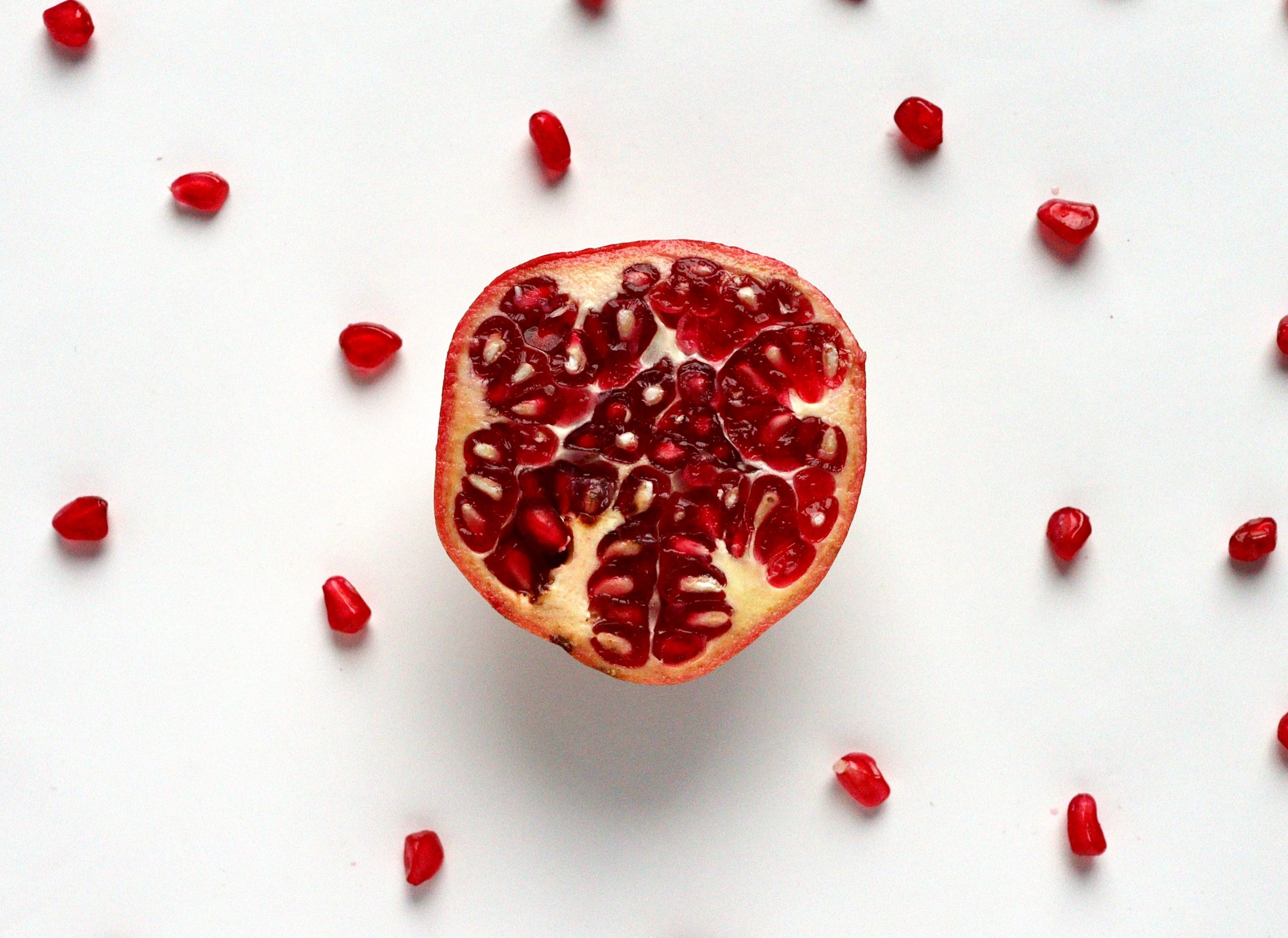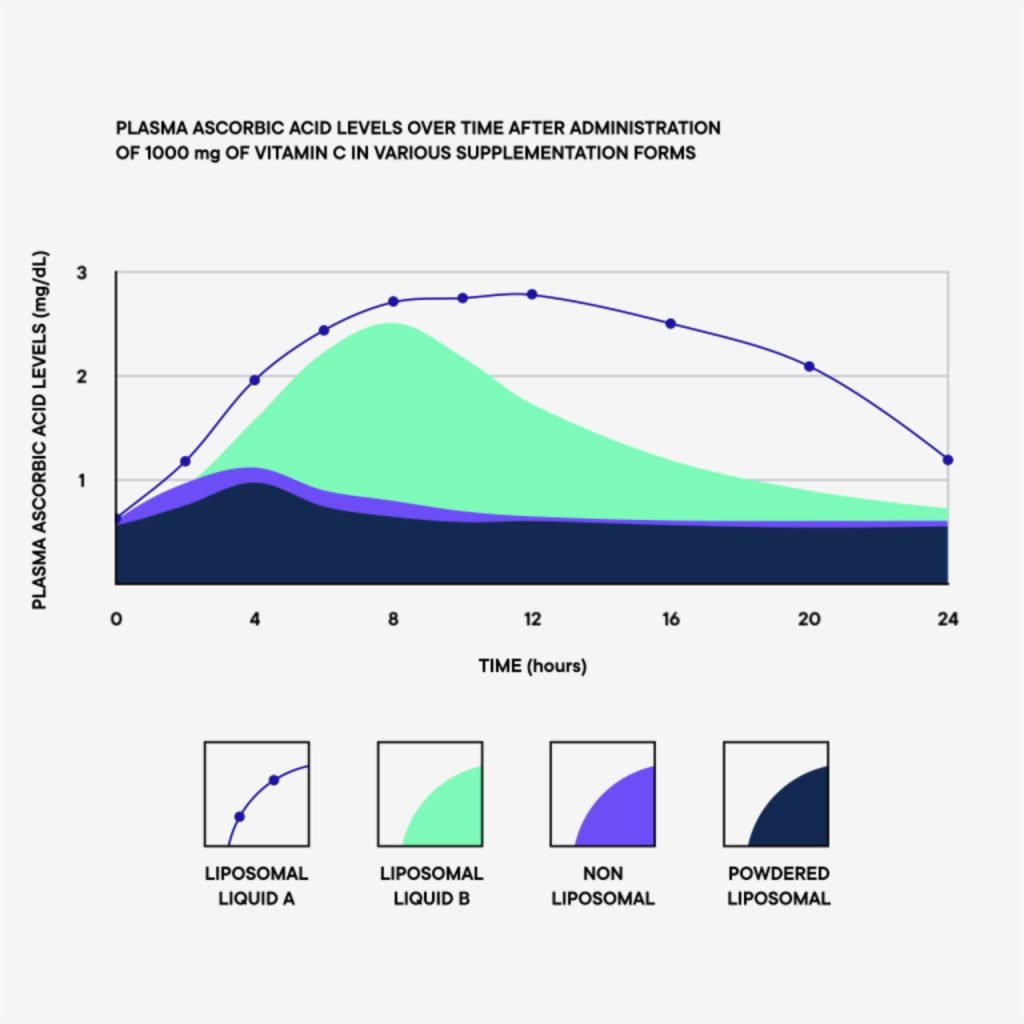Vitamin C is an essential part of our diet, and is one of the most popular dietary supplements on the market. A bioavailability study that we performed with our liposomal vitamin C formulation had surprising results.

Benefits of vitamin C
Vitamin C (ascorbic acid) plays an important role in various functions of our body such as (1):
- Maintaining the normal function of the immune system
- Helping with collagen formation for the normal function of blood vessels, bones, cartilage, gums, skin and teeth
- Ensuring the normal functioning of the nervous system
- Reducing tiredness and fatigue and
- Helping to protect cells from oxidative stress
Limitations of vitamin C
As listed above, there are many reasons for taking vitamin C supplements. The most important reason is that the human body is unable to produce this water-soluble vitamin by itself (2). It is essential, therefore, that we consume adequate doses of this essential, water-soluble vitamin through our diet or food supplements.
In the market, doses of vitamin C higher than 500 mg/day are sold as high-dose supplements. The argument for high-dose vitamin C is that the DRV recommendation is for healthy people; however when the body is under stress or when one is ill, higher dosages are required to counter these “attacks” (4,5). Unfortunately, there are also two well-known problems with consuming high-dose ascorbic acid supplements.
- Taking high dosages of vitamin C orally doesn’t necessarily mean more of it is absorbed. There is a limit to how much the body can absorb. In fact, scientific studies have shown that at single doses above 1000 mg/day, absorption falls to less than 50% (2). This makes high dosages inefficient.
- The more you take, the more likely you will get unpleasant GI side effects such as nausea and diarrhoea.
Fortunately, encapsulation of the vitamin into liposomes could help with both of these problems.
Liposomes are the solution
The GI distress caused by too much vitamin C is due to osmotic forces. This basically means vitamin C attracts water, leading to dehydration. In turn, this can cause various unpleasant side effects (2).
By encapsulating vitamin C in liposomes, the exposure to the GI tract is reduced. This reduces its dehydrating side effects (5).
Additionally, the absorption of vitamin C in the intestine is carried out through a number of cellular transporters. However, these transporters are easily saturated leading to a limited absorption of vitamin C from supplements (5). Packing vitamin C into liposomes could help it passively cross the intestinal cells and avoid these intestinal transport barriers. Further, due to the re-direction of the liposomes into the lymphatic drainage, the encapsulated vitamin C is directly deposited into the bloodstream. Since the cells of the rest of the body have a different set of transporters for vitamin C, more vitamin C is directly absorbed from the blood (5).
Why did we study our formulation?
The purpose is to show that liposomal encapsulated supplements can really make a difference to supplement absorption. With this human study, we wanted to prove that our product can overcome the problems associated with high-dose vitamin C absorption.
The Study
The bioavailability study described here was performed in association with our study partner, Surya Research Clinics, India.
What did we look at
We tested 40 healthy volunteers (20-50 years) divided randomly into four equally sized groups. This is an adequately sized group for pilot tests like ours. Here is a list of the formulations that each group were given:
- LLA group were given our liquid liposomal vitamin C (liposomal product A)
- LLB group were given a competitor’s liquid liposomal formulation.
- PL group were given powdered liposomal vitamin C in capsule form.
- NL group were given powdered non-liposomal vitamin C in tablet form
Each group consisted of 10 participants, with each being given 1000mg of vitamin C in the assigned form.
The study was performed over a 24 hour period. Blood was drawn before giving the participants the supplements (a baseline measurement). These baselines values of vitamin C in circulation for the participants were almost the same and any differences were not statistically significant. This means that each group started on a level playing field.
Blood was then drawn every two hours for the first 12 hours after supplementation, and every four hours for the next 12 hours. The circulating levels of vitamin C were then determined in the laboratory. We did this for all the study groups in order to measure how quickly and effectively the supplements were absorbed.
The Science
This section gets a bit technical so you may wish to skip to part 3 below.
Once we received the lab results for the participants, we calculated three important markers:
- Cmax – the maximum blood concentration of vitamin C (taking the average for the group).
- Tmax – The time at which the maximum occurred.
- AUC – The area under the curve, which gives the best overall picture.
This essentially tells us about bioavailability. In other words, how much of an ingested nutrient reaches the bloodstream, for how long it stays there, and thus how much of it can actively be used by the body.
Our findings

Cmax – Maximum Blood Concentration
As can be seen from the table, our liposomal vitamin C (shown in the column for the LLA group) gave the highest maximum blood concentration, which was slightly higher than the competitor’s liposomal formulation and significantly higher than for the powdered and non-liposomal forms.
The above findings tend to confirm what we suspected: that liquid liposomal formulations are able to help vitamin C overcome gastrointestinal barriers and enter the bloodstream.
Tmax – Time until Maximum Blood Concentration
As can be seen in the graph below, an increase in circulating vitamin C levels were detected in all groups soon after supplementation. In the group that received the Mighty Kids formulation the concentration gradually increased over a period of 12 hours, and remained elevated for much longer.
This strongly suggests that liposomal encapsulation could lead to a sustained release of vitamin C into the bloodstream where its effect then last longer, reducing the need for repeated dosing.

Conclusion
- The Mighty Kids liquid liposomal formulation was over 12 times more bioavailable than the non-liposomal supplement, and over 21 times more bioavailable than the powdered liposome formulation.
- Vitamin C concentrations for the Mighty Kids group were still increasing long after the other two groups had already reached their peak. Our liquid liposomal supplement continued to slowly release vitamin C into the bloodstream long after the competitor’s supplements.
- While the other study groups reached baseline plasma levels by the end of the study period, the group that received our liquid liposomal formulation had still not reached baseline levels.
Our study suggests that the amount absorbed from a single dose of our liposomal vitamin C formulation is higher compared to the other tested products. This could mean that food supplements, like vitamin C, that were limited by their poor absorption in the past can now also become powerful tools thanks to liposomal technology.
References
- [Online] EU Register of nutrition and health claims made on foods (v.3.6). Accessed on 25.10.2022
- [Online] Vitamin C: NIH Fact Sheet for Health Professionals. Accessed on 25.10.2022
- [Online] Dietary Reference Values for the EU. Accessed on 25.10.2022
- [Online] Passwater RA. Oral High-Dose Vitamin C for Major Diseases. WholeFoods magazine. 2017.
- Prantl L, Eigenberger A, Gehmert S, Haerteis S, Aung T, Rachel R, Jung EM, Felthaus O. Enhanced Resorption of Liposomal Packed Vitamin C Monitored by Ultrasound. J Clin Med. 2020;9(6):1616.








